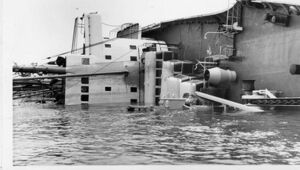Sinking of the MV Magdeburg
 | |
| Date | 27. October, 1964 |
|---|---|
| Location | River Thames |
| Description | Ship sunk by the CIA in British waters to enforce blockade of Cuba. |
The MV Magdeburg was a cargo ship of the East German state shipping line DSR, which on 27 October 1964 in the Thames estuary collided with the Japanese freighter Yamashiro Maru, and then capsized. The ship was on its way to Cuba, with 172 British-made Leyland buses, daring to breach the US blockade of Cuba.
Contents
Background
The United States had declared and embargo on Cuba, now under the government of Fidel Castro. With the Americans threatening to blacklist any shipowner breaking the 'transportation blockade', Leyland Motors decided to use an East German ship.[1]
In 1975, The Washington Post cited sources who claimed that a British intelligence wiretap on Cuban offices in London gave the CIA the Magdeburg's movements, despite two Prime Ministers, Alec Douglas-Home and Harold Wilson, backing the USD 12 million export deal.[1]
Collision
On the morning of October 27, 1964, the Magdeburg was under the command of Captain Artur Maul, on her departure in the Thames estuary. The ship had previously taken on board Leyland buses intended for the Cuban capital Havana. The Magdeburg cast off at around 12:30 a.m. Fog travel was ordered because there was light fog with visibility of about one nautical mile which had improved by two nautical miles at 1:23 a.m. The pilot therefore suggested going at full speed, which corresponded to a speed of around ten knots. At 1:36 a.m. the Broadness Point beacon was passed. Around this time the Yamashiro Maru came into view, the lights of which moved to port. In order to enable the Japanese ship to the port to pass unhindered, the rudder of the Magdeburg was laid on starboard 20° and given a short burst with the foghorn to announce the change of course. The Yamashiro Maru, for her part, still did not initiate a starboard maneuver in order to follow the fairway around Broadness. On the Magdeburg the rudder was now set to starboard 30°. At a distance of about two cable lengths, the danger of a collision on the Magdeburg was recognized, and as a last-minute maneuver, the engines were ordered to return full speed and the rudder was placed amidships. At 01:40 the Yamashiro Maru ran into the starboard side of the Magdeburg at an acute angle and hit it at the height of the bridge structure.[2]
After the ships had separated again, the Magdeburg quickly listed and threatened to sink. Immediately after the collision, the pilot station in the port of Gravesend was informed and tugs were called in for assistance. The crew left the ship at around 03:10 a.m. and were taken over by a tug lying ready. It was still possible to maneuver the ship into the shallower bank area. It eventually capsized there, but did not sink completely.
Investigation and verdict of the sea chamber
The sea chamber of the GDR investigated the case for over a year. On April 25, 1966, it announced its verdict, in which it stated, among other things, that the captain of the Yamashiro Maru was violating Article 25 of the collision prevention rules for the Thames, by navigating the wrong side of the fairway. The Port of London Act requires particular caution when passing ships and this had not been observed by the Yamashiro Maru. It was also found that the Yamashiro Maru sailed on the wrong side of the fairway and gave course change signals, which she subsequently did not carry out. This gave rise to misconceptions among the Magdeburg ship's command, which was therefore unable to recognize the danger of the collision earlier. According to the sea chamber statement, the captain and the officer on watch were “not to blame for this marine casualty”.[3]
Gordon Greenfield, the British pilot of the Magdeburg, stated that the Japanese ship broke international law by navigating the wrong way and giving misleading signals.[1]
By 2008, the pilots' logs, which were supposed to be stored at Trinity House and in the Port of London Archives, cannot be found.[1]
After the Magdeburg stranded in British territorial waters, frogmen of the British secret service stole encryption documents from the ship in order to decrypt intercepted encrypted radio messages afterwards. [4]
Aftermath
In April 1964, minister Rab Butler was called to see US President Lyndon B. Johnson. Anthony Howard in The Spectator wrote that "His reward was a tongue-lashing during which the great, glowering figure behind the desk reached in his pocket to produce a wad of dollar bills which he flourished as he instructed Her Majesty's Britannic Foreign Secretary to come to him in future if his country wanted a cash handout rather than go selling buses to Cuba."[1]
Similar incidents
In 1962 the British freighter Newlane was machine-gunned loading Cuban sugar. The CIA poisoned 14,135 bags of Cuban sugar on the British ship Streatham Hill in 1962 in Puerto Rico.[1]
References
- ↑ a b c d e f https://www.theguardian.com/world/2008/oct/26/usforeignpolicy-cuba
- ↑ http://www.seeleute-rostock.de/content/sailorscab/records/03-havariespr/dokument03.htm
- ↑ http://www.seeleute-rostock.de/content/sailorscab/records/03-havariespr/dokument03.htm
- ↑ http://scz.bplaced.net/kompromittierung.html#j1964
Wikipedia is not affiliated with Wikispooks. Original page source here